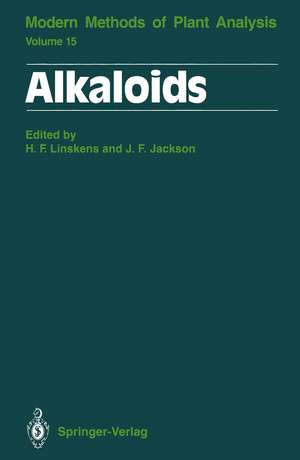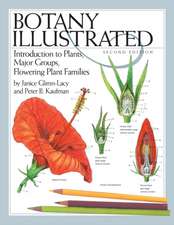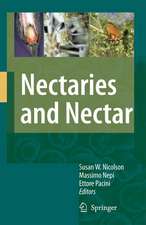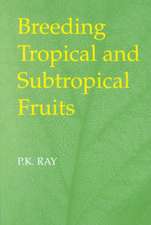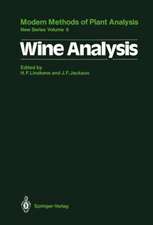Alkaloids: Molecular Methods of Plant Analysis, cartea 15
R.A. Anderson Editat de Hans-Ferdinand Linskens J.C. Callaway Editat de John F. Jackson R.C. Crouch, D. Dagnino, M.M. Gupta, J.D. Hamill, J. D. Martin, T. Naaranlahti, P.R. Nelson, M.W. Ogden, A.J. Parr, J. Schripsema, J.R. Sharma, R. Verpoorte, W.W. Weeks, C.A. Wilkinsonen Limba Engleză Paperback – 29 dec 2011
Din seria Molecular Methods of Plant Analysis
- 15%
 Preț: 623.39 lei
Preț: 623.39 lei - 15%
 Preț: 618.34 lei
Preț: 618.34 lei - 18%
 Preț: 862.04 lei
Preț: 862.04 lei - 18%
 Preț: 1180.96 lei
Preț: 1180.96 lei - 15%
 Preț: 617.57 lei
Preț: 617.57 lei - 15%
 Preț: 611.57 lei
Preț: 611.57 lei - 15%
 Preț: 612.55 lei
Preț: 612.55 lei - 15%
 Preț: 610.18 lei
Preț: 610.18 lei - 18%
 Preț: 913.45 lei
Preț: 913.45 lei - 15%
 Preț: 613.31 lei
Preț: 613.31 lei - 18%
 Preț: 910.71 lei
Preț: 910.71 lei - 18%
 Preț: 913.45 lei
Preț: 913.45 lei - 18%
 Preț: 1171.58 lei
Preț: 1171.58 lei - 18%
 Preț: 1171.87 lei
Preț: 1171.87 lei - 15%
 Preț: 619.12 lei
Preț: 619.12 lei - 15%
 Preț: 616.95 lei
Preț: 616.95 lei - 15%
 Preț: 616.28 lei
Preț: 616.28 lei - 15%
 Preț: 623.22 lei
Preț: 623.22 lei - 15%
 Preț: 620.68 lei
Preț: 620.68 lei -
 Preț: 384.48 lei
Preț: 384.48 lei - 15%
 Preț: 622.11 lei
Preț: 622.11 lei
Preț: 613.94 lei
Preț vechi: 722.28 lei
-15% Nou
Puncte Express: 921
Preț estimativ în valută:
108.64€ • 127.39$ • 95.41£
108.64€ • 127.39$ • 95.41£
Carte tipărită la comandă
Livrare economică 16 februarie-02 martie
Preluare comenzi: 021 569.72.76
Specificații
ISBN-13: 9783642842283
ISBN-10: 3642842283
Pagini: 260
Ilustrații: XVIII, 237 p. 3 illus.
Dimensiuni: 155 x 235 x 14 mm
Greutate: 0.37 kg
Ediția:Softcover reprint of the original 1st ed. 1994
Editura: Springer Berlin, Heidelberg
Colecția Springer
Seria Molecular Methods of Plant Analysis
Locul publicării:Berlin, Heidelberg, Germany
ISBN-10: 3642842283
Pagini: 260
Ilustrații: XVIII, 237 p. 3 illus.
Dimensiuni: 155 x 235 x 14 mm
Greutate: 0.37 kg
Ediția:Softcover reprint of the original 1st ed. 1994
Editura: Springer Berlin, Heidelberg
Colecția Springer
Seria Molecular Methods of Plant Analysis
Locul publicării:Berlin, Heidelberg, Germany
Public țintă
ResearchCuprins
Isolation, Identification, and Structure Elucidation of Alkaloids A General Overview.- 1 Introduction.- 2 Isolation.- 3 Identification and Structure Elucidation.- 4 Strategy.- 5 Future Prospects.- References.- Inverse-Detected 2D-NMR Applications in Alkaloid Chemistry.- 1 Introduction.- 2 Historical Background.- 3 Suppression of Unwanted Magnetization Arising from 1H-12C Species.- 4 Inverse-Detected One-Bond Heteronuclear Shift Correlation Experiments.- 5 Long-Range Heteronuclear Chemical Shift Correlation - HMBC.- 6 HMQC-TOCSY and Other Hyphenated Inverse-Detected 2D Experiments.- 7 Other Inverse-Detected NMR Experiments -Selective and F1 Region-Selected Experiments.- 8 Sample Requirements.- 9 Applications of Inverse-Detected NMR Techniques to Alkaloid Chemistry. Structural Problems.- 10 Conclusion.- References.- Electrochemical Detection of Alkaloids in HPLC.- 1 Introduction.- 2 Principles of HPLC with Electrochemical Detection.- 3 Methods of Detection in Plants.- 4 Possible Methods for Detecting Other Alkaloids.- 5 Conclusions and Future Directions.- References.- Gas Chromatography in the Analysis of Alkaloids.- 1 Introduction.- 2 Pyrrolizidine Alkaloids.- 3 Quinolizidine Alkaloids.- 4 Tropane Alkaloids.- 5 Quinoline Alkaloids.- 6 Morphinan Alkaloids.- 7 Terpenoid Indole Alkaloids.- 8 Ergot Indole Alkaloids.- 9 Steroidal Alkaloids.- 10 Diterpenoid Alkaloids.- 11 Other Alkaloids.- 12 Conclusion.- References.- Alkaloid Analysis in Flue-Cured Tobacco.- 1 Introduction.- 2 Factors Affecting Alkaloid Concentration.- 3 Methods of Analysis of Tobacco Alkaloids.- 4 Summary.- References.- Assessment of Burley and Dark Tobacco Alkaloids During Storage, Aging, and Fermentation.- 1 Importance of Pyridine Alkaloids to Tobacco Quality and Usability.- 2 Importance of Storage, Aging,and Fermentation.- 3 Chemical Analyses.- References.- Detection of Alkaloids in Environmental Tobacco Smoke.- 1 Introduction.- 2 Overview of Sampling and Analysis Methods.- 3 Time-Integrated Sampling/Gas Chromatographic Analysis.- 4 Real-Time Sampling/Mass Spectrometric Analysis.- 5 Summary.- References.- Methods for Production of Alkaloids in Root Cultures and Analysis of Products.- 1 Introduction.- 2 Induction of Transformed Roots.- 3 Proof of Transformation.- 4 Alkaloid Extraction and Quantification.- References.- Genetic and Chemical Analysis for Alkaloids in Papaver.- 1 Introduction.- 2 Genetics of Major Opium Alkaloids and Importance of Chemical Analysis.- 3 Chemical Analysis of Major Opium Alkaloids.- 4 Concluding Remarks.- References.
